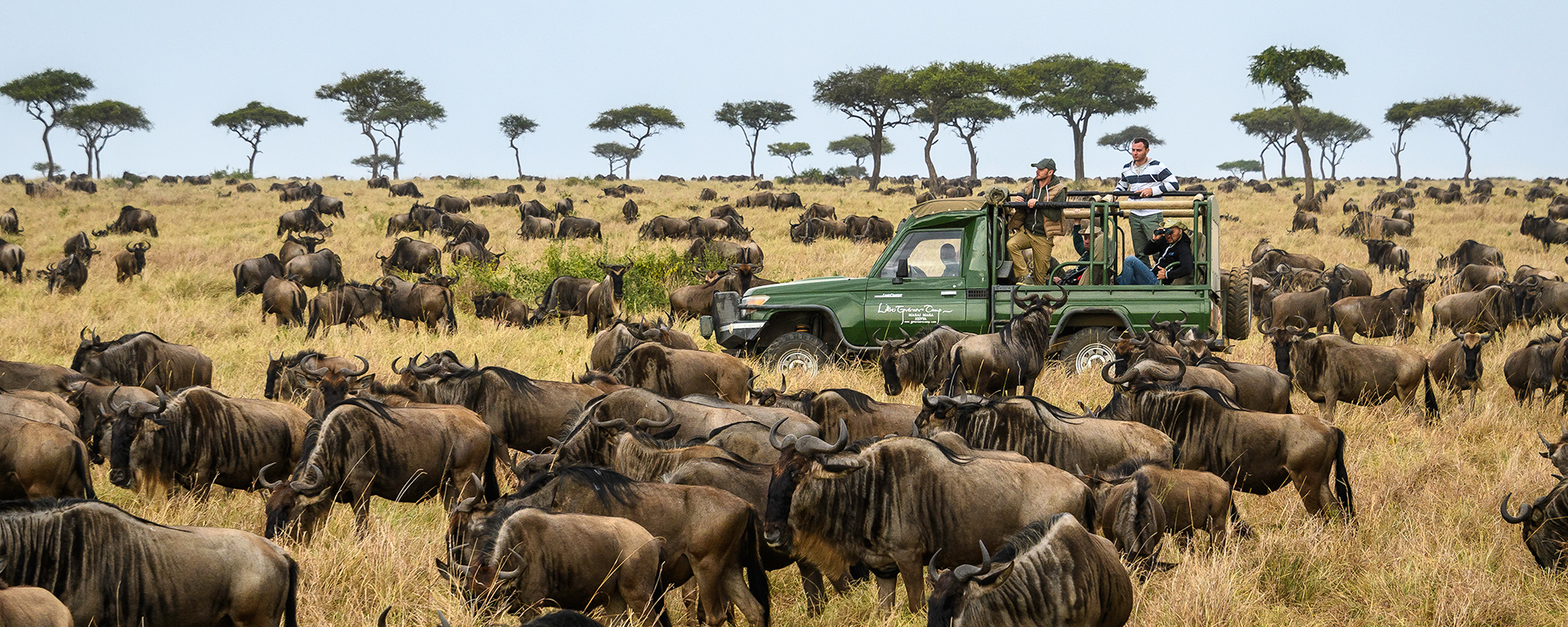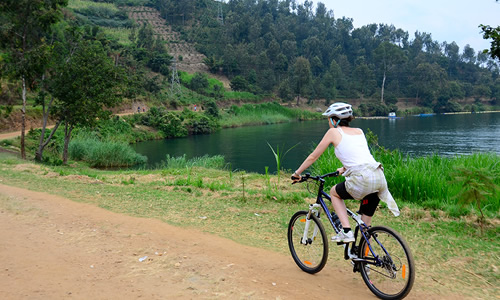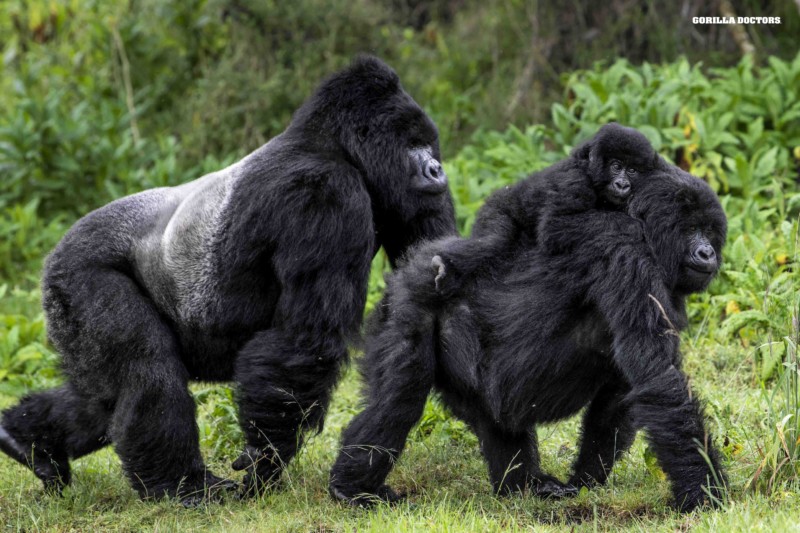Your guide to the Great Migration
The Great Wildebeest Migration
Your guide to the Great Migration : The great wildebeest migration is one of the most sought – after safari experiences for wildlife and nature enthusiasts, the migration is regarded as one of the natural wonders in the world and the largest migration of land mammals in the world.
The Great Migration is an ever – moving circular migration of over 2 million wildebeests together with gazelles and zebras across the Serengeti – Mara ecosystem, these animals move in search for water and green pastures and their movement is constant following an age – old route in search for grazing and water. After calving in the Southern part of Tanzania’ Serengeti near the Ngorongoro Conservation in Ndutu area, the animals trek through the Serengeti up and around in a clockwise direction towards the Masai Mara national reserve in Kenya, before returning once again near the end of the year.
Their journey is filled with drama as thousands of animals are taken by predators such as crocodiles, leopards, lions and thousands more are born, thus replenishing the numbers and sustaining the circle of life.
In this article, you will learn more about what the Great Migration is, how the migration moves in details in different times throughout the year and some of the frequently asked questions about the Great Migration.

What is the Great Migration?
The Great Migration is the largest herd movement of animals on the planet with up to 1,000 animals per square kilometer, the great columns of wildebeests can be clearly seen from space.
The numbers of animals taking part in the migration are astonishing, over 1.2 million wildebeest and 300,000 zebras long with topi and other gazelles move in a constant cycle through the Serengeti – Mara ecosystem in search for nutritious grass and water, these animals are guided by survival instinct and each wildebeest will cover about 800 to 1000 kilometers on its individual journey along age – old migration routes. The herds face attacks from hungry predators including lions, leopards, cheetahs, hyenas, wild dog and crocodiles and only the strongest survive in this natural spectacle which is also known as “The greatest show on Earth”.
The circuit takes the animals from the Ngorongoro Conservation Area (although not in the crater itself) in the south of Serengeti national park in Tanzania, up through the Serengeti and across into the Masai Mara national reserve in Kenya and back again.
The journey is filled with danger as young calves are snatched by predators such as prides of lions, brave breasts break legs on steep river slopes, crocodiles also feast on the straggling, the weak and the exhausted ones frown.
The 3 groups of Migrant grazers have different grass – eating habits, one group eats the top of the tallest grass, the next group will eat away some of the medium – height grass, until it is finally it is almost completely eaten and the herds move on. This each group sticks to their own kind with only a small overlap in their distributions.
The grasses of the plains have the highest protein content in the whole of the Serengeti and they are high in calcium.
It is not clear how the wildebeests know which way to go, but it is generally believed that their journey is dictated primarily by their response to the weather. They follow the rains and the growth of new grass, while there is no scientific proof of it, some experts believe that the animals react to lightning and thunderstorms in the distance, according to some suggestions, the wildebeests can locate rain more than 50 kilometers away.
How the Great Migration moves throughout the year
Whether the wildebeests are giving birth to calves or attempting to cross rivers while avoiding predators, the migration is constantly on the move throughout the year. The Great Migration tends to be in different areas in different times of the year.
The Great Migration in January, February and March
Around January each year, the Migration will be finishing its southward trek, moving along the eastern edge of the Serengeti and enter into the Ngorongoro Conservation Area where the plains are rich in nutritious grass, providing the herds with the best conditions for raising their newly born calves.
Although there is no real beginning or end of this migratory circuit, other than birth and death, it seems reasonable to call the wildebeests’ birthing season “calving season” the start of the migration. Around late January or February, the herds occupy the short – grass plains that spread over the lower northern slopes of the Ngorongoro Crater highlands and around Olduvai Gorge. About 400,000 calves are born here within a period of two to three weeks, nearly 8,000 new calves are born every day.
The abundance of vulnerable young calves means attract predators which spring into action, hunting with ease due to the sheer numbers of wildebeests. Those interested in witnessing calving and the drama of big cats on the hunt should visit the Southern Serengeti in January, February and March.
The Great Migration in April and May
After birth to their young in February and March, around April the wildebeest herds begin to trek northwest toward the fresher grass of the central Serengeti together with thousands of zebras and smaller groups of antelopes.
By May, columns of wildebeests stretch for several kilometers as the animals start to congregate by the Moru Kopjes, close to Dunia Camp – one of the few camps in the Serengeti offering migration viewing at this time of the year. Towards the end of May, the Mating Season begins and male wildebeests battle head to head.
Through “the rut”, the journey continues at leisure with the wildebeests, zebras and gazelles grazing as they go along. Gradually the movement gathers momentum and the wildebeests start to mass in the western corridor of Serengeti , the herds form in huge numbers along the pools and channels of the rivers which they have cross in order to continue their journey.
This may not be as spectacular as the famous Mara crossings but there are still enough wildebeest to provide the Grumeti crocodiles with a veritable feast, it is worth noting that may offer a low season in Serengeti yet the wildlife viewings remain excellent.
The Great Migration in June and July
June marks the start of the dry season with large concentrations of wildebeests in the western Serengeti and on the Southern banks of the Grumeti River. Each migrating animal must face the challenge of crossing the crocodiles infested river, the first of many daunting and tense river encounters.
As June moves into July – the hundreds of thousands of wildebeests and zebras continue to head north along the western edge of the park toward an even riskier barrier, The Mara River in the north of the Serengeti.
These river crossings are arguably one of the most exciting wildlife event of Earth, they usually begin at the onset of high season in July but timing all depends on nature.
The herds will typically be found in the Northern Serengeti in the month of July, later in July the animals that have successfully made it across the Mara River will now be in Maasai Mara national reserve in Kenya.
At this time, daily crossings can be seen at the Mara and Talek River both offering incredible scenes.
The Great Migration in August, September and October
By August, the herds have faced the challenge of crossing the Mara River and are spread throughout the Masai Mara’s northern region with many remaining in the northern Serengeti. in years when the river is in full flow, the panic and confusion at the crossing combined with waiting predators and surging currents cause massive loss of life.
The crocodiles take a toll on the crossing animals and the large predators such as the lions patrol the banks, ready to ambush any wildebeest that make it to the other side of the river. There is no single crossing, at some spots there are just a few individuals while others see a mass of animals moving without break for hours.
By September to October, the main chaos has ended and the migrating columns have gradually moved eastward, however the wildebeests will face the heavy waters of the Mara River once more as they prepare to cross once again for their return journey southward.
The Great Migration in November and December
After the East African short rains in the late October and early November, the wildebeests move down from Kenya and into the eastern limits of the Serengeti past Namiri Plains, an area known for outstanding cheetah sightings.
By December, the animals are spread throughout the eastern and southern reaches.
In the early months of the New Year, the grasses in the deep south of the Serengeti are lush with rain, this draws the herds of wildebeests and hundreds of thousands of zebras and other plains animals.
The cycle of The Great Migration continues as the Calving season starts once again.
Commonly asked Questions about The Great Migration
Do wildebeest Migrate
Throughout every year in East Africa, wildebeests along with Zebras, gazelles and other animals migrate in spectacular herds comprising of millions of animals altogether across Kenya and Tanzania, this is known as The Great Migration.
What is the best time to see the Great Wildebeest Migration?
The Great Migration can be enjoyed year round, the first few months of the year offer exceptional predator encounters in Serengeti national park in Tanzania as well as the calving season for the wildebeests and newborns make for easier targets.
By July, the herds re heading north into the Central Serengeti where the wildebeests make their first river crossing and take their chances against the hungry waiting crocodiles.
In August, the herds cross over into Kenya’s Masai Mara and towards the end of the year the herds move southwards back into Serengeti where animals brace themselves for the next calving season and predator attacks.







